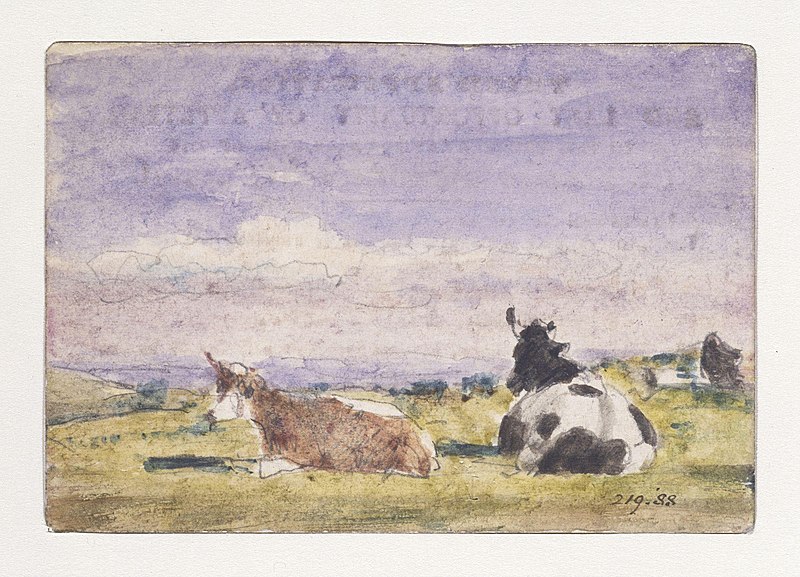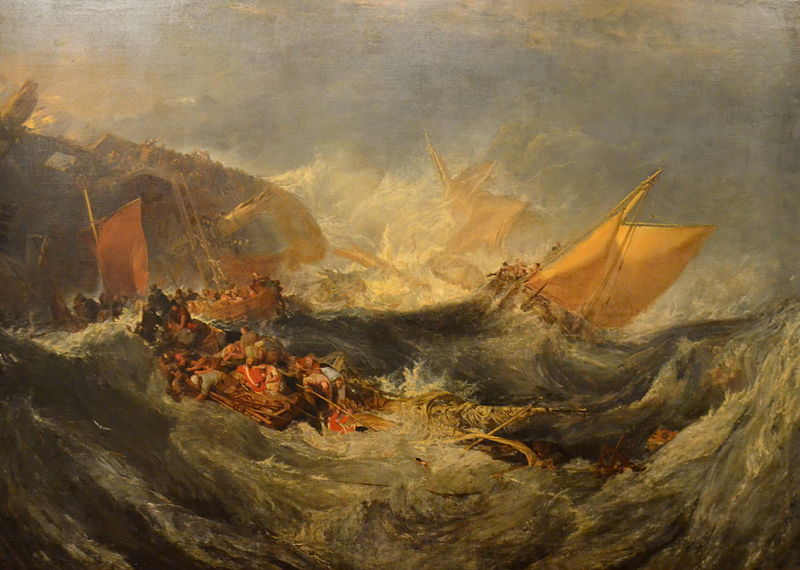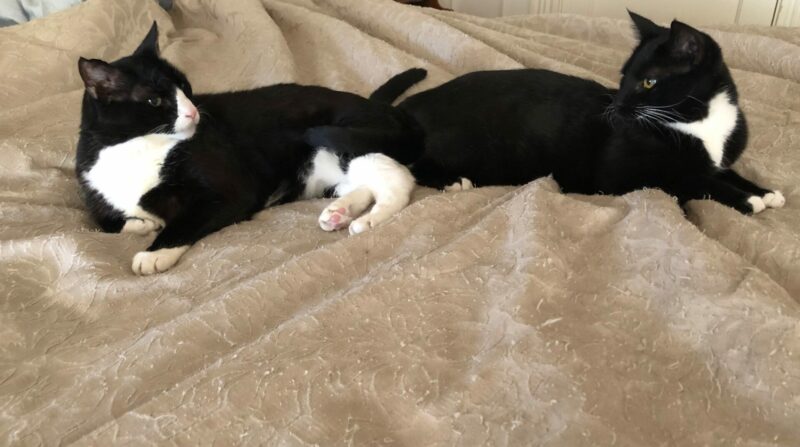I’m a terrible front-pager these days, for lots of reasons. (Primarily–waaaaay late on a book MS, and so trying to force myself to write only that until the draft goes to the editors. But also emotional brittleness that has only ramped up through to today, if you know what I mean and I fear you do.) I have intentions, but I make no promises, certainly not til the aforementioned book (temporarily) leaves my desk.
But desperate times require desperate measures, so rather than just sit, relying on my emotional support Champ and Tikka, I thought I’d toss up a quick hit on a couple of fun stories that came across my science-news screen at different intervals.
Going back to 2019, here’s the abstract from one of my all time favorites:
Experimental and comparative studies suggest that the striped coats of zebras can prevent biting fly attacks. Biting flies are serious pests of livestock that cause economic losses in animal production. We hypothesized that cows painted with black and white stripes on their body could avoid biting fly attacks and show fewer fly-repelling behaviors. Six Japanese Black cows were assigned to treatments using a 3 × 3 Latin-square design. The treatments were black-and-white painted stripes, black painted stripes, and no stripes (all-black body surface). Recorded fly-repelling behaviors were head throw, ear beat, leg stamp, skin twitch, and tail flick. Photo images of the right side of each cow were taken using a commercial digital camera after every observation and biting flies on the body and each leg were counted from the photo images. Here we show that the numbers of biting flies on Japanese Black cows painted with black-and-white stripes were significantly lower than those on non-painted cows and cows painted only with black stripes. The frequencies of fly-repelling behaviors in cows painted with black-and-white stripes were also lower than those in the non-painted and black-striped cows. These results thus suggest that painting black-and-white stripes on livestock such as cattle can prevent biting fly attacks and provide an alternative method of defending livestock against biting flies without using pesticides in animal production, thereby proposing a solution for the problem of pesticide resistance in the environment.
Yup. You read that right. Putting cows in zebra suits helps fend off chomping bugs. Who says science is dry?
And then, from last week, an abstract with some sad history and fascinating observations:
Historic shipwrecks form an anthropogenic landmark in marine environment, yet their influence on the local geochemistry and microbiology remains largely unexplored. In this study, sediment and steel hull samples were taken around the V-1302 John Mahn, a World War II shipwreck, at increasing distance from the wreck, in different directions. Polycyclic aromatic hydrocarbons (PAH’s), explosives, and heavy metal levels were determined and related to the microbial composition. Benz(a)anthracene and fluoranthene remain present at the mg kg-1 level, probably originating from the coal bunker. These PAH’s indicate that the wreck is still influencing the surrounding sediments however the effects are very dependent on which side of the wreck is being studied. Known PAH degrading taxa like Rhodobacteraceae and Chromatiaceae were more abundant in samples with high aromatic pollutant content. Moreover, sulphate reducing bacteria (such as Desulfobulbia), proven to be involved in steel corrosion, were found present in the biofilm. This study shows that even after 80 years, a historic shipwreck can still significantly steer the surrounding sediment chemistry and microbial ecology.
In a 2016 project, a University of Nebraska-Lincoln team studied the corrosion of the U.S.S. Arizona, which sank in the attack on Pearl Harbor in 1941. The researchers estimated that the battleshipheld hundreds of thousands of gallons of oil but could remain structurally stable because of a buildup of organisms on the vessel.
Cool!
The consensus seems to be that military shipwrecks in particular present environmental risks because of the ordnance they carry, but that they do not create large-scale hazards. Still, it’s sobering to think that the sea floor itself retains a lasting memory of war.
Anyway: I’m in an anything but election doomscrolling mode, and I thought others might be as well–so enjoy!
The thread is open.
ETA: Annnnddd….Readership capture! This is for rikyrah:
The rare six-legged pushmi-pullu.
Images: John Constable, Study of cows at Hampstead, before 1837.
J. W. M. Turner, Wreck of a transport ship, 1810.




rikyrah
Wait…no Champ and Tikka pictures?
Boooooo
Jerzy Russian
Is this a euphemism for something the kids are doing these days?
Not me.
Kristine
While folks here were busy being amazing, I had a web meeting with new attorney about estate planning. Then I cleaned the living room post-construction (I had a pass-through made so my very dark living room could grab some of the dining room’s southern exposure). Missed all the online jabber, which is possibly a good thing. I don’t have cable so unless I sign up for Sling or some other service tonight I’ll have to rely on this place along with the occasional glimpse at Twitter (still there) and Mastodon (it’s growing).
Another Scott
Hang in there Tom, and everyone.
Re the cows, I was expecting to see this, also too:
Cheers,
Scott.
Tom Levenson
@Another Scott: That little video is amazing.
Leslie
Kitties!
Good luck with the book, Tom, and thanks for the cool science.
dm
Didn’t that zebra-stripe research get an Ig Nobel this past award season[1]? It seems to me I heard that story recently.
When I heard it, it made me wonder if it explained the okapi’s tail-section stripes.
[1] Nope. No mention of zebras on the list of Ig Nobel winners: https://en.wikipedia.org/wiki/List_of_Ig_Nobel_Prize_winners
Warren Senders
When it comes to fun science, I would contribute my father’s 1968 study on the attentional demands of safe driving. He received an IgNobel for this work in 2011:
https://www.youtube.com/watch?v=kOguslSPpqo
gene108
https://www.nytimes.com/2022/03/30/magazine/shackleton-ship-endurance.html
PBS News Hour YouTube of the ship
schrodingers_cat
@rikyrah: I second this demand
Gorgeous duo of tuxie kittehs!
Tom Levenson
@gene108: That’s so spooky.
One of the Many Jens
Very cool, thank you!
trucmat
This thread managed to remind me of Omni Magazine. Couldn’t get enough of it when I was a teen.
MagdaInBlack
❤️ @The Dr. Dolittle reference.
randy khan
One of the notable things when you visit the Arizona memorial is that you can see that the ship is still leaking fuel or oil, or something else organic, as there are little slicks on the water.
And, mashing stuff together, I’m posting kitteh photos on social media tonight to help distract people from looking at results.
Splitting Image
It’s going to be tough watching A Funny Thing Happened at the Way to the Forum without pedantically mentioning that to whoever is in the room. The opening sequence contains some workers painting zebra stripes on a horse.
raven
My dad’s ship, the USS Crosby was the sister ship of the Ward and took on many of her crew when the Ward was sunk.
The video is not as striking as that of the Endurance but still interesting.
raven
@Splitting Image: Thrice in Thrace?
SpaceUnit
No one here in Colorado goes camping without their zebra suit.
Duh.
Spanky
Well damn. I see a lone Powerball ticket in California was the big ($2.04B) winner.
Guess I oughta buy a ticket next time!
sab
I spy with my little eye a seventh leg (or some toes) belonging to Tikka.
trollhattan
Going along with the thread’s spirit, how cool is this find in Tuscany?
“Hey, let’s you and me go take a bath, and toss in some art?”
“Sounds great!”
J R in WV
Aren’t there hundreds of military vessels on the bottom of the sea by now? And all of them with tons of munitions, bunker fuel oil, and all the chemical paints, solvents, etc that ships carry. To my detailed information as a former Bosun’s Mate. AKA painter and cleaner.
My ship, AS-16 carried something like 600 torpedoes to resupply submarines with, and untold thousands of gallons of bunker fuel for the ship and (at the time I joined the ship) the diesel powered subs in its squadron. It was never sunk, thankfully, but to think of the tons and tons of pollutants it would have carried to the bottom with it…
Zebra stripes to fight biting insects, sounds good to me, but I have no personal info to contribute.
I’m avoiding the election results, Wife is watching MSNBC and I can hear the blather, but am ignoring it to the best of my ability.
WaterGirl
@rikyrah: Tom just sent me an amazing photo of the two of them for the pet calendar.
Tom Levenson
@J R in WV: Thousands. And yes. Lots of nasty stuff lurks on the sea floor.
raven
@J R in WV: Here’s a list for ya.
raven
Pacific Wrecks is a not-for-profit 501(c)(3) charity dedicated to bringing home those Missing In Action (MIA) and leveraging new technologies in the study of past conflicts.
And that’s just the Pacific. It’s estimated that 200,000 people died in the Battle of the Atlantic and that’s a lot of ships.
Feathers
Black Twitter is dragging the white pride Viking crowd:
In the thread the terms “Snowteps” and “We wuz Vikangs” emerged. Needed the laugh. There were also several reminders that potatoes are Peruvian and only in Europe for the last 500 years or so.
eclare
@J R in WV: Avoiding election news here too. I don’t want to hear any prognosticating. I will wait to hear results.
Starfish
@SpaceUnit: I never go camping because I cannot afford one of those fancy zebra suits.
eclare
@raven: I still hate that at the WWII museum in NOLA we started with the European theater wing and hardly had any time for the Pacific. Definitely a two day visit museum, but we only had one.
raven
@eclare: Ha, my old man wouldn’t go! “I had 27 goddamn D-days in the Pacific”! When they dedicated the Pacific Wing we met there and he rode on one of the many trucks carrying WW2 vets in a parade. They seemed truly stunned at the outpouring from the crowd that day. I’ve been back twice since they remade it and built the new building across the street from the original building.
SpaceUnit
@Starfish:
Yeah, sadly it’s gentrified the wilderness.
eclare
@raven: That’s great! It is such a treasure
I went with my aunt and uncle, and he had mobility issues so our time was limited. He was in the Army after WWII and was stationed in Italy. His big story is he once saw Truman Capote in a bar there.
raven
@eclare: My old man was at a USO show on Guadalcanal and, while in the head, Artie Shaw reached to shake and said “shake hands wi the hand that played with Ava Gardner’s ()U**&^*^*”!
eclare
@raven: Whoa! That beats seeing Truman Capote by miles!
Quinerly
@raven: wow.
My dad went to college with Ava in Wilson, NC. One of his fraternity brothers dated her briefly and my dad double dated with them. I have his college yearbook from the one year she attended Atlantic Christian College (now Barton College) that she signed to my dad. Her mom worked at the college. Great little Ava museum in Smithfield, NC. They just had a little festival commerating her 100th birthday. She’s buried nearby. It was said by quite a few that my mom looked like Ava during that time period.
billcinsd
So with the Arizona stuff, there is some stuff they have yet to consider. I worked with Don Johnson and Dana Medlin taught at my University for ~5 years and is a friend of mine. My research group has kind of taken over the Arizona research, as all the UNL Professors are either retired or deceased, with NPS Submerged Resources Group. A couple things we have been working on lately — 1. Rivet corrosion. It is possible that rivets will exhibit galvanic corrosion and therefore corrode much faster than expected. This could lead to corrosion compromising the ship much earlier than 200-250 years currently expected. 2. Concretion analysis. As an iron ship sits on the bottom, concretions build up on the surface, making oxygen transport to the metal much more difficult, slowing corrosion. We have been doing computed tomography and X-ray Fluorescence to better model these concretions and therefore more accurately determine the corrosion rate. We have some other irons in the fire, but I need some finite element modelers to be able to work with me this summer for them to come off
kalakal
@raven: Almost the entire German WW1 Navy was scuttled at Scapa Flow in the Orkneys in 1919. The fleet was interned there after the German surrender. Most have since been recovered. The remaining ships are in very deep water and periodically small batches of steel are brought up. This steel is used in the manufacture of radiation-sensitive devices, such as Geiger Counters, as it was produced before any chance of nuclear contamination
https://www.bbc.com/news/uk-scotland-48599958.amp